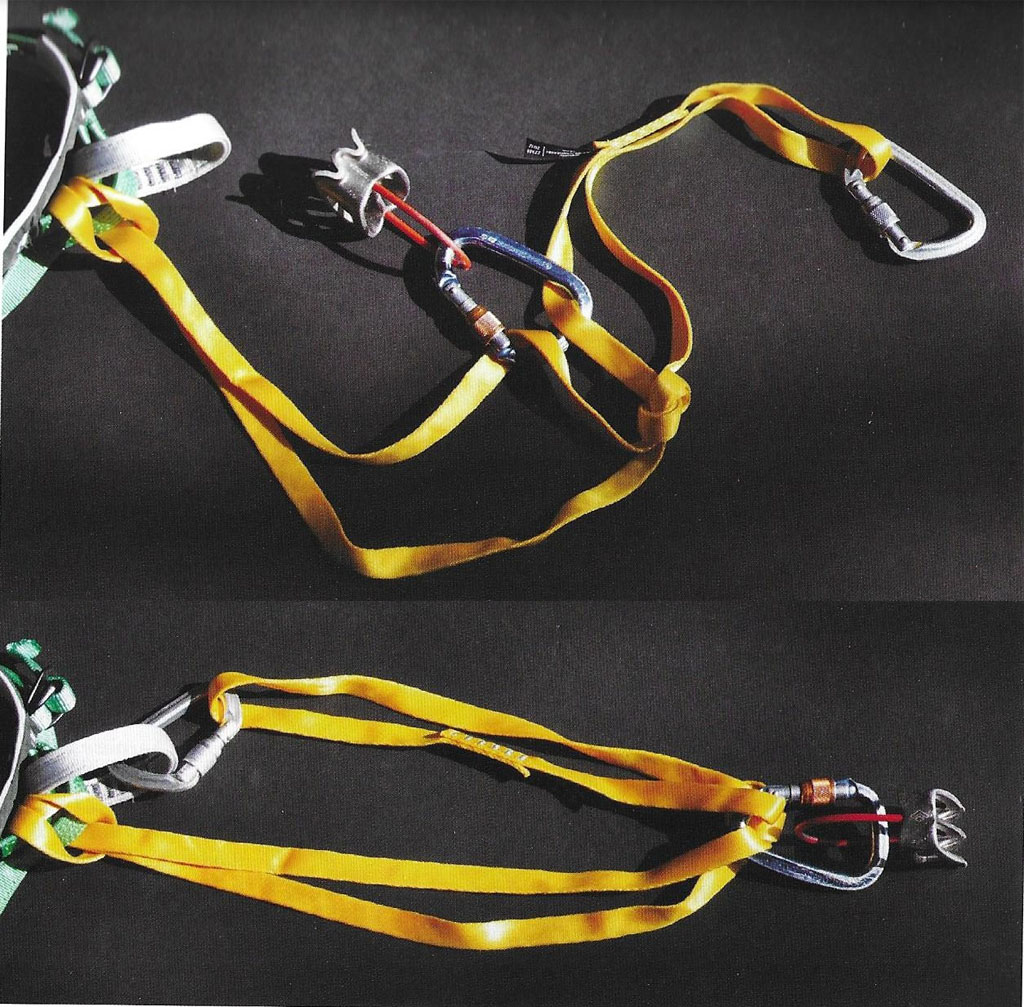Rappelling With Autoblock Backup
Introduction
This is not a substitute for learning this hands-on with an experienced instructor. Rappelling is statistically one of the more dangerous activities in climbing. You are totally dependent on your equipment. Most of the rappelling accidents reported could have been prevented with the proper use of backup techniques such as an autoblock and tying knots in the end of the ropes. Many climbers feel that backing up is unnecessary and too time consuming. Those are the people who make it into the annual “American Alpine Club: Accidents in North America Mountaineering.” An excellent video that demonstates the method shown below: http://vimeo.com/54302232
Rigging for Rappel
Both ropes
have to be fed through the belay/rappel device and
secured to the locking carabiner.
The locking carabiner should be through
your sling extenstion.
The rappel system must be backed up to provide redundancy so that, for
example,
if the belay loop failed you would not plummet to the ground.

Autoblock with 2 ft sewn sling
You should use a 4 foot runner/sling tied in the middle with an overhand knot (figure 1. It extends the rappel device away from your harness. The carabiner and belay device is attached to both loops on either side of the know to ensure redundancy. The advantage of this is it gets the belay device farther away from your autoblock and because it is threaded through both your harness’s leg loops and waist belt in a girth hitch, and it is knotted, it provides a further degree of redundancy. The autoblock is connected to the leg loop near the belay loop and away from the leg loop buckle. You connect another carabiner to the top loop so that you can easily clip in to the anchor on a multi-pitch rappel (figure 3 and 4). When rappelling attach this biner back to a belay loop as shown below.

Rappel set-up with extended sling and autoblock connected to belay loop. Hand is below the autoblock for illustration but you would have your hand above the autoblock or on the autoblock to slide it down as you rappel.
When rappelling you slide the autoblock down the rope with your break hand (right-hand on the rope above the autoblock as shown below) so that it won't be pulled up the rope (causing it to lock). Now, if you let go of your brake hand accidentally (if you are hit by a falling rock) or need to use both hands to do something such as unclip a quickdraw or take a photo, the autoblock will lock down on the rope and hold you in place. To release the autoblock, simply pull it downward. It releases easily because it is only asked to take the place of your brake hand, and thus only has to hold a small amount of weight, the same amount you hold with your brake hand to stop yourself.
|  |

Check to make sure both rope bights are through the carabiner.
Knots In The End of the Rope
You should always tie a large knot, such as a tripple stopper (AKA barrel) knot on the end of each rope unless you are on a one-pitch climb and you can clearly see that both ends of the rope are on the ground. If you do this, you will never run the risk of rappelling off the end of your rope. This is a common accident. A well known climbing guide fell to his death in Red Rock Nevada when he rappelled off the end of his ropes.

Stopper knot at end of the rope
Tying Two Ropes Together
Tying two ropes together provides you with a 200 ft (using 60m ropes) rappel. When tying the rope together use an overhand knot as shown below. Make sure that you pull all strands of the rope hard in all directions to firmly set the knot before rappelling. Tie an overhand knot in one of the tails to prevent the knot from inverting. If the ropes are significantly different diameters then it is then this thinner rope that should be tied off with an overhand knot around the other tail, snug against the knot, to prevent the knot from inverting.

Overhand knot used to tie two ropes together.
Rappelling
Check, double check, triple check your rappel rigging. Weight the system while still clipped into the anchor. Back over the cliff edge keep your upper body upright, feet out on the cliff, and descend butt first. Rappel as smoothly as you can, walking down the wall. Go slow with short steps avoiding bounding or bouncing as much as possible. This will keep you in control and minimize the stress and wear on your equipment and the anchor.
Separate the two strands of rope to minimize kinking while descending. If you're careful not to tangle the ropes during descent, retrieving them will be easier.
Keep all loose clothing, hair, slings, helmet straps, and all other equipment away from your rappel device so nothing gets caught in it.
Keep your brake hand on the rope by your hip, feeding rope out by relaxing your fingers and sliding the autoblock down the rope.
Always watch where you are going so you are not caught by surprise by a ledge or overhang. Stay in the fall line so you don’t swing if you lose your footing. On a multi-pitch rappel, stay on rappel until you are securely clipped to the next anchor.
Once down securely clipped in to your anchor or on the ground yell up “Off rappel” to the person above you after you have come out of the rappel device and autoblock.


